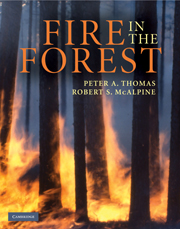Book contents
- Frontmatter
- Contents
- Preface
- List of contributors
- 1 In the beginning
- 2 Historical review
- 3 How a fire burns
- 4 Fire in the wild landscape
- 5 Fire ecology
- 6 The benefits of fire and its use as a landscape tool
- 7 Fire suppression
- 8 Wildland fire and its management – a look towards the future
- Further reading
- References used in the text
- Index
8 - Wildland fire and its management – a look towards the future
Published online by Cambridge University Press: 05 August 2012
- Frontmatter
- Contents
- Preface
- List of contributors
- 1 In the beginning
- 2 Historical review
- 3 How a fire burns
- 4 Fire in the wild landscape
- 5 Fire ecology
- 6 The benefits of fire and its use as a landscape tool
- 7 Fire suppression
- 8 Wildland fire and its management – a look towards the future
- Further reading
- References used in the text
- Index
Summary
The age of uncertainty
In 1899 Gifford Pinchot, who in 1905 became the first Chief of the United States Forest Service (USFS), wrote an article for National Geographic magazine entitled ‘The relation of forests and forest fires’ in which he stated, ‘That fires do vast harm we know already, although just what the destruction of its forests will cost the nation is still unknown.’ Influenced by European views of forestry and founded on the belief of human mastery over nature, the passionate and charismatic Pinchot, along with his understudies and eventual successors, led a crusade against fire that was considered both morally acceptable and economically desirable. Forests, like other natural resources, were deemed valuable assets to be used to meet immediate human needs and increase the wealth of those who owned them. Pinchot's conservationist vision ‘to control the use of the earth and all that therein is’ (Cortner & Moote 1999) was confidently thought to be not only plausible but completely possible owing to an era of tremendous optimism in western society at that time. Reaping the benefits of the industrial revolution, including the steam engine, electricity and the telephone, human progress was fuelled by a philosophy of scientific determinism that viewed the world and how it functioned as orderly, machine-like, and therefore predictable as well as controllable. The famous author H.G. Wells captured this sentiment in 1902 in his address at the Royal Institution of Great Britain suggesting that if humans were to channel the same level of scientific effort on the future as had been placed on understanding the past it would be possible to predict what lies ahead with certainty.
- Type
- Chapter
- Information
- Fire in the Forest , pp. 183 - 210Publisher: Cambridge University PressPrint publication year: 2010



